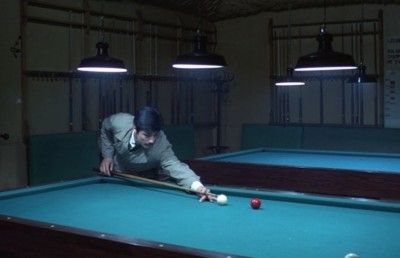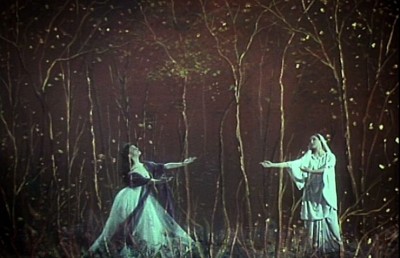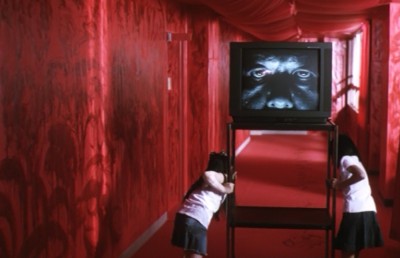Local and Global Identity in European film
The examples of Snatch and Carne Trémula

The European cinema industry, like the Canadian one, is continually faced with competition from Hollywood. European films have to compete against the gigantic marketing power and globally-recognized stars of American films. Moreover, the smaller population of many European countries means that even films that are very successful domestically still lose money if they cannot reach a wider international audience. Film theorist Dimitris Eleftheriotis once stated that the financial survival of European cinema depends on “the production of films that can effectively cross cultural and national borders.” [1] He further suggests that European films that profitably cross cultural barriers may be of two categories:
…either those of the great European auteurs which had and still have a guaranteed run in the art-house cinemas across the world, or block-busters which explore ‘universal’ themes and embrace the globally recognizable Hollywood production values and style. [2]
For an exploration of local and global identity in European film, then, I felt it appropriate to choose a film from each category outlined above. Carne trémula (Live Flesh) (Pedro Almodóvar, 1997) is by a recognized Spanish auteur filmmaker, while Snatch (Guy Ritchie, 2000) adopts the mainstream Hollywood aesthetic, even taking it to extremes. There is, however, some overlap between the categories: in Carne trémula, Almodóvar embraces international themes and Hollywood narrative style more than in his previous films (as will be discussed below), and Snatch??’s general similarity to Richie’s first film, ??Lock, Stock and Two Smoking Barrels (Guy Ritchie, 1998), lends support to the view of Ritchie as a well-known director with a distinctive cinematic style.
There is no denying that both Carne trémula and Snatch were intended for an international audience. Nevertheless, both films construct modern local identities as well, centred respectively on Spain (specifically Madrid) and Britain (specifically London), while simultaneously addressing issues of global identity and of the relationship between the local and the global. I will begin by examining the use of local identity markers for the benefit of both the local and international audience. Then I will explore how global identity is established, focusing primarily on the exploitation of universal themes and tropes and the integration of foreign elements within the narrative. Finally, I will discuss how the films construe the relationship between local and global identities, taking into account both the narrative of the films and their production.
In both films, the setting is immediately noticeable and very conspicuous throughout the film. Carne trémula??’s soundtrack is characteristically Spanish, featuring traditional-sounding Spanish songs, while the cinematography features several shots of Madrid landmarks; Victor’s house is in fact in the shadow of the distinctive Caja Madrid towers. There is also a tribute to the famous Spanish director, Luis Buñuel, with a clip from one of his films. In ??Snatch, on the other hand, the opening line identifies the protagonist as British: “My name is Turkish. Funny name for an Englishman, I know.”
At times, the use of national stereotypes or icons and the repeated references to the location are so conspicuous that it seems likely they are being exaggerated for the benefit of an international audience. For example, Centro’s (Pilar Bardem) remark after Victor’s (Liberto Rabal) unexpectedly early birth seems somehow implausible: “You were in a big hurry to get to Madrid, and here you are. [Holding his face up to the bus window] Look Victor, Madrid!”. A general, non-geographical greeting would be more natural. Carne trémula is also the fist Almodóvar film to explicitly make reference to conditions under the Franco regime (the film opens in the Franco era, with a declaration of a state of emergency and the suspension of civil liberties). One explanation for this decision may be that although domestic audiences are weary of the topic, an international audience unfamiliar with Spain’s past might need that background to understand the context of the modern social situation in Madrid. In Snatch, on the other hand, Ritchie relies on stereotypical icons of British culture. The Union Jack, for example, appears unexpectedly throughout the film (for example, on Tyrone’s dashboard and Doug’s socks). The frequent references to tea (a distinctly British tradition in contrast to the American preference for coffee) are also present: Brick Top (Alan Ford) interrupts his busy gangster life on several occasions for tea breaks, and Vinnie and his gang use a tea cosy to blindfold their hostage.
Of course, a domestic audience would be aware that these films are being marketed internationally; this fact would presumably affect the reception of the film. Almodóvar and Ritchie are, in a sense, ambassadors of their national cultures, and domestic audience members might rate the film based on their approval or disapproval of how their country and their nationality is being portrayed to the world. It is fairly clear that both directors are presenting what they believe to be a positive view of their countries, although those portrayals vary substantially. The final words of Carne trémula, spoken by Victor to his soon-to-be-born child, are dangerously close to being a cheesy endorsement of post-Franco Spain:
Twenty-six years ago, I was in the same situation, about to be born. But you’re much luckier that I was. It’s so different now. Look at the sidewalk, full of people. When I was born, there wasn’t a soul on the street. People were shut up at home, scared shitless. Fortunately for you, son, in Spain we stopped being scared a long time ago.
The message here is that the new Spain is full of possibilities.
Ritchie also attempts to construct a new identity for Britain. Snatch self-consciously alludes to foreign perceptions of England, particularly through the American character Avi (Dennis Farina), who reveals his view of London with the outburst, “You know, fish, chips, cup o’ tea, bad food, worse weather, Mary fucking Poppins… London!” It seems counter-intuitive that a film centred on the criminal underworld might portray a desirable cultural identity, but the fact is Ritchie represents an exciting, hip image of Britain. This identity provides an alluring alternative for a young, modern audience that does not relate to the identity portrayed in traditional British prestige films and costume dramas. Snatch is also a twist on post-war British crime dramas: “In the serious thrillers of the earlier period we were not invited to find the criminals attractive or sympathetic. […] [The protagonists] were no laughing matter and they were made to pay for their crimes.” [3] Enthusiasm for Ritchie’s new vision is not unanimous, however, as one critic notes, “The blame for what is seen as the pollution of British film culture is usually laid at the door of Guy Ritchie.” [4]
Given that Pedro Almodóvar and Guy Ritchie use their films to present a specific vision of Spain and Britain respectively, they must also construct their films in such a way as to be globally appealing in order for that vision to be introduced to an international audience. They accomplish this by employing universal themes and by embracing the Hollywood aesthetic.
Carne trémula is an adaptation of British author Ruth Rendell’s novel by the same name (Live Flesh), although Almodóvar retains very little from the original. Nevertheless, crediting a foreign writer as the inspiration for his film—a first for Almodóvar—is a bold statement that the story is not uniquely Spanish in nature. Although his revisions do make it specific to Spain, the main story revolves around the universal themes of love, passion, guilt, and fortune. The director is quoted as saying that his affinity for Hollywood narratives was once considered one of his weaknesses: “In my films there was always a story to tell, and that was not accepted, it was too Hollywood, and not conceptual enough for the independent and underground guys who improvised with a camera.” [5] Moreover, in this film Almodóvar shies away from some of the more controversial characteristics that defined his earlier films, especially the representation of a wide spectrum of gender identities and sexual preferences ranging from necrophiliacs to lesbian masochists to transgendered prostitutes.
In terms of cinematic style, Snatch is a direct contrast to what might be considered typically British. When considering the success of British films in the American market, theorist Nick James quotes J. Arthur Rank’s 1940s list of American objections to British films, which he claims “still seem relevant today.” In fact, Ritchie’s film seems almost designed in response to the following complaints:
1. The action was too slow.
2. There was too much dialogue.
3. The actors talked too fast and their accents and slang words were difficult to understand.
4. The actresses looked dowdy and the actors seemed effeminate.
5. The physical quality of the films often looked inferior to American productions. [6]
By contrast, Ritchie’s film is fast-paced and centred around action as much as dialogue, and the men are anything but effeminate. The actors all take care to enunciate every word, with the exception of Brad Pitt whose character is meant to be unintelligible. Finally, the physical quality of the film shows an improvement even beyond the high quality sound and visual editing of Ritchie’s previous film.
Both Carne trémula and Snatch avoid excessive cultural specificity by emphasizing the power of the individual in constructing his own identity. In Carne trémula this is manifested in Victor, who tries to rebuild his life after being released from prison, and in Clara, who decides she no longer wants to play the role of the submissive wife. In Snatch, individual identity construction is portrayed humorously; as Steve Chibnall notes, the film features “a gaggle of men who impersonate Jews (‘good for business’), a Russian who dresses like an English country gent, and travellers (‘pikeys’) who exaggerate their own dialect for commercial advantage.” [7]
We have now seen how various types of identity are constructed, but perhaps more interesting is an examination of the relationship between the local and the global. This can be considered both within the narrative and in terms of the production of the film. Within the narrative, both films present contrasting perspectives of the local-global relationship. Carne trémula presents a welcoming, inclusive view of local identity; Elena is Italian and yet she is not portrayed as being essentially different from the other characters. Any divisions between characters are based on personal factors, not identity constructions of in-groups and out-groups. The characters come and go —Sancho takes his wife to therapy in Portugal and David goes on holiday to Miami— although the action itself is focused on Madrid. The only exception is a clip of the 1992 Paralympics in Barcelona, an event that, in conjunction with the regular Olympics, focused the world’s attention on Spain. Almodóvar’s new Spain is not an isolationist one, as it may have been under Franco; instead, it is an important member of a global society.
In Snatch on the other hand, constructed identities tend to be much more divisive. The characters can easily be classified into clear groups such as the black Londoners or the travelling Irish “Pikeys,” and many are characterized with reference to their ethnicity. For example, Boris, the Russian character (who turns out to be Uzbekistani), is described as “as bent as the Soviet sickle and as hard as the hammer that crosses it.” While all the groups are in competition with one another, the competition seems to achieve a certain balance. Everybody is taking advantage of everybody else to a more or less equal extent. While Snatch portrays a London full of various ethnicities, it does seem vulnerable to Chibnall’s criticism that:
In contrast to the determined efforts of many indigenous films of the last twenty years to present an inclusive, multi-ethnic portrait of modern Britishness, the gangster cycle indicates a retrenchment and narrowing of view. […] There is a marked tendency to prioritise the concerns of young white heterosexual metropolitan Englishmen. [8]
Certainly, if there is a protagonist in Snatch, it must be Turkish, the white Englishman who narrates the film. Unlike Carne trémula where all the action is in one city, Snatch shows the links between London, Antwerp and New York. London is in fact given the prestigious honour of being the centre of a multinational crime ring.
In addition to international elements in the narratives, there are important international elements to the production of the films. Both films are international co-productions—Carne trémula between Spain and France, and Snatch between the UK and the United States. Both also feature an international cast, with Carne trémula starring Italian actress Francesca Neri and Snatch featuring Hollywood heartthrob Brad Pitt. While both actors are undeniably talented and well suited to their roles, they also serve an important purpose in the marketing of the film to an international audience.
Although the cultural and artistic goals of the filmmakers are no doubt important, one cannot overlook the commercial side of filmmaking when considering the choices made by the directors. Almodóvar’s international success is due as much to his business savvy as to his artistic ability, leading one critic to note that, “Almodóvar and his films are heir to an ambivalent legacy generated by over half a century of tensions between government-sponsored attempts to define and perpetuate a national cultural tradition and the sundry enticements of an apparently liberating but no less restrictive transnational culture industry. His skill in negotiating such creative and commercial faultlines no doubt represents an important factor in his global appeal.” [9] In comparison with some of Almodóvar’s earlier, more controversial films, Carne trémula seems especially designed for this negotiation of creative and commercial considerations, seeking a place in the global marketplace for his vision of Spanish culture.
If Almodóvar deviated from his earlier style, Ritchie by contrast was criticized for essentially remaking his first film. Newsweek, for example, complained, “he’s made the same movie over again, with a bigger budget and with Brad Pitt in a funny and flashy supporting role.” [10] The films may be similar, but the differences are nonetheless important. The play between British and American identity that is so key to the humour of Snatch (for instance, Avi’s answer to the customs officer’s question “Anything to declare?” is “Yeah, don’t go to England.”), as well as the use of an A-list Hollywood star and American funding, indicate that Snatch is marketed to a more international—especially American—audience. A quick look at the box office receipts confirms that Ritchie’s strategy paid off. While Lock, Stock and Two Smoking Barrels grossed £11,399,953 in the UK, it made only $3,650,677 in the US. By contrast, Snatch did only marginally better domestically (£12,137,698) while it increased its American box office takings by over 800% ($30,093,107). [11]
In summary, Carne trémula and Snatch are excellent examples of how a careful combination of local and global identity markers may be used to satisfy both cultural and commercial goals. Through the use of universal themes and a globally accepted visual style, a film can appeal to an international audience. An increased international distribution can also be promoted through international funding and the use of foreign stars, and the internationally appealing film can then be used to promote a specific version of a local identity. When all these factors come together successfully, the result is a film that brings a national culture into foreign cinemas around the world and also brings significant revenue back to the filmmaker and the nations investing in the film.
Endnotes
1 Dimitris Eleftheriotis, Popular Cinemas of Europe: Studies of Texts, Contexts and Frameworks (London: Continuum, 2001), p. 49
2 Ibid, p. 52
3 Brian McFarlane, “The More Things Change … British Cinema in the 90s” in The British Cinema Book: Second Edition. ed. by Robert Murphy, (London: British Film Institute, 2003), pp. 273-280, p.267
4 Steve Chibnall, “Travels in Ladland: The British Gangster Film Cycle 1998-2001” in The British Cinema Book: Second Edition. ed. by Robert Murphy, (London: British Film Institute, 2003), pp. 281-291, p.281
5 Kathleen M. Vernon and Barbara Morris, Post-Franco, Postmodern: The films of Pedro Almodóvar (London: Greenwood Press, 1995), p. 6
6 Nick James, “They Think It’s All Over: British Cinema’s US Surrender” in The British Cinema Book: Second Edition. ed. by Robert Murphy, (London: British Film Institute, 2003), pp. 301-309, p. 304
7 Chibnall, “Travels in Ladland”, p. 285
8 Ibid., p. 289
fn9.Vernon and Morris, Post-Franco, Postmodern, p. 5
10 David Ansen “Lock, Stock, Same Barrel: Ritchie back on familiar London gangland turf,” Newsweek, Jan 22, 2001, p. 61
11 All figures taken from the “Box Office & Business” section of the respective films’ pages on the Internet Movie Database













